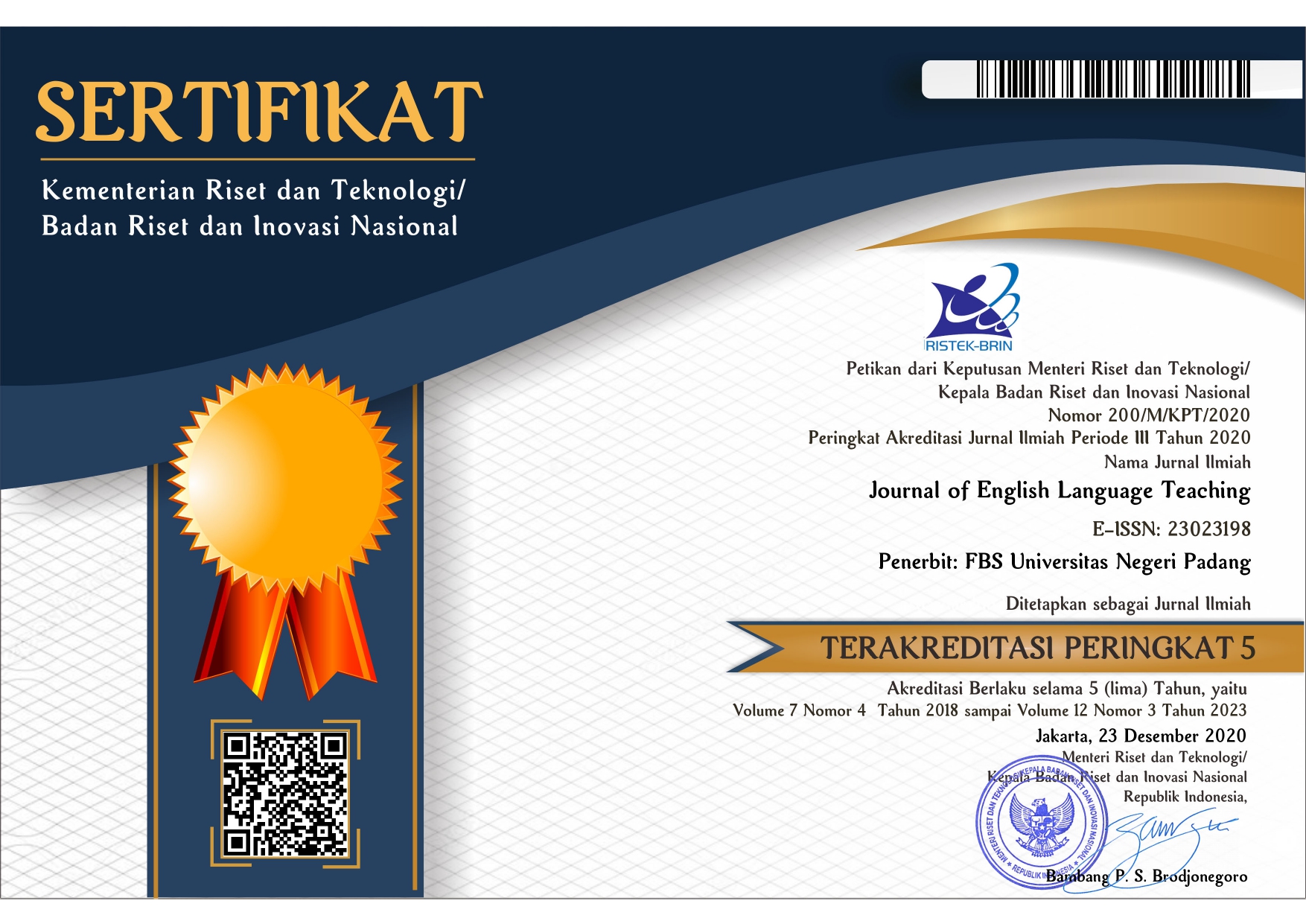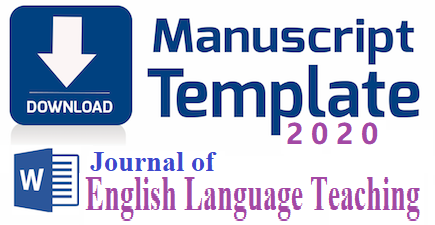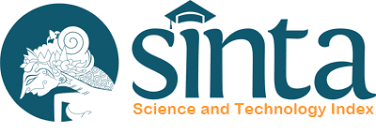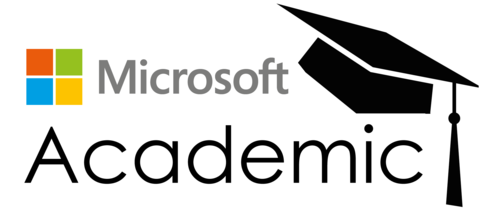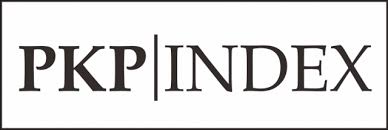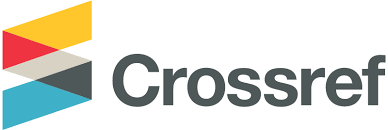The Effect of Using Digital Children’s Literature on Storynory.com to EFL College Students’ Vocabularies at English Department, FBS, UNP
 ), Leni Marlina(2),
), Leni Marlina(2), (1) Universitas Negeri Padang
(2) Universitas Negeri Padang
 Corresponding Author
Corresponding Author
Copyright (c) 2024 Qaula Harisya Gumay
DOI : https://doi.org/10.24036/jelt.v13i1.127196
Full Text:
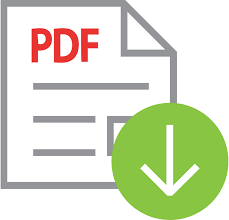 Language : en
Language : en
Abstract
References
Abd Rahman, Umanailo, M. C. B., Bin-Tahir, S. Z., Saumur, A. S., Ibnu, S., Iskandar, A. M., & Hastuti, H. B. P. (2021). The influence of digital folktales on the students’ English vocabulary mastery of SMP Negeri 9 buru. Proceedings of the International Conference on Industrial Engineering and Operations Management, 5180–5187. Retrieved from https://doi.org/10.46254/an11.20210879
Adrianti, I. E., & Marlina, L. (2022). The Use of Magoosh Application to Enhance EFL College Students ’ Vocabularies at English Department FBS UNP. Journal of English Language Teaching, 11(2), 263–271. Retrieved from https://doi.org/10.24036/jelt.v11i2.117300
Ahwida, A., & Marlina, L. (2023). Journal of English Language Teaching Digital Children ’ s Literature Storynory . Com Impact to English Department UNP ’ s Listening Anxiety of EFL College Students, 12(3). Retrieved from https://doi.org/10.24036/jelt.v13i2.124782
Alifah, S., Supriyati, Y., Dudung, A., Salman, I., & Widodo, A. (2021). Analysis Of Digital Literature Factors On Junior High School Students (Case Study on SMP 3 In Bekasi District) Siti. International Journal of Education, Information Technology and Others (IJEIT), 4, 345–352.
Andricos, A. R., & Marlina, L. (2023). Journal of English Language Teaching The Effect of Using Digital Children’s Literature on Storybookscanada.ca To Students’ Vocabularies at SMAN 5 Padang Article History Abstract, 12(4), 1123–1131. Retrieved from https://doi.org/10.24036/jelt.v12i4.125820
Apriltya, R., & Arifin, Z. (2016). the Use of Digital Story in Teaching Reading Narrative Text for Smp Students. Jurnal Pendidikan Dan Pembelajaran, 5(4), 1–11.
Asnita, J., & Marlina, L. (2022). The Use of English Children’s Literature to Enrich EFL College Students ’ Vocabularies and Reduce Their Reading Anxiety at English Department UNP. Journal of English Language Teaching, 11(2), 249–262. Retrieved from https://doi.org/10.24036/jelt.v11i2.117297
Astuti, W. (2022). USING FLASHCARDS TO INCREASE STUDENTS ’, 10(2), 106–118.
Bobkina, J., & Stefanova, S. (2016). Literature and critical literacy pedagogy in the EFL classroom: Towards a model of teaching critical thinking skills. Studies in Second Language Learning and Teaching, 6(4), 677–696. Retrieved from https://doi.org/10.14746/ssllt.2016.6.4.6
Hai-yan, Z. (2008). Values and limitations of children ’ s literature in adult language education. Education, 6(3), 18–22.
Harris, D. P. (1974). Testing a Second Language, 84–85. Retrieved from Library of Congress Catalog
Ho, L. (2000). Children’s literature in adult education. Children’s Literature in Education, 31(4), 259–271. Retrieved from https://doi.org/10.1023/A:1026431003032
Huang, C.-F. (2017). Approaching Reading Development through Children’s Literature: Insights from A Case Study of the University Student with Low English Proficiency. Journal of Arts and Humanities, 6(3), 86. Retrieved from https://doi.org/10.18533/journal.v6i3.1129
Kadek Mita Lasmini, Ni Ketut Suarni, & I Wayan Widiana. (2022). Buku Digital Berbasis Scrapbook Terhadap Literasi Baca Tulis Siswa Kelas III SD. Journal for Lesson and Learning Studies, 5(2), 259–266. Retrieved from https://doi.org/10.23887/jlls.v5i2.50869
Kuntarto, H. B., & Prakash, A. (2020). Digital Literacy Among Children in Elementary Schools. Diakom : Jurnal Media Dan Komunikasi, 3(2), 157–170. Retrieved from https://doi.org/10.17933/diakom.v3i2.92
Lukens, R. J. (2007). A Critical Handbook of Children’s Literature 8th Edition (8th ed.).
M. Arafik, M. (2017). The Implementation of Children Literature Instruction in Elementary School, 45(CoEMA), 277–281. Retrieved from https://doi.org/10.2991/coema-17.2017.48
Phakiti, A. (2014). Experimental Research Methods in Language Learning. Bloomsbury Academic.
Pudjiati, D., & Fitria, T. N. (2022). Digital literacy in learning listening skill between English and Non-English Department students through educational video. Leksika: Jurnal Bahasa, Sastra Dan Pengajarannya, 16(1), 33. Retrieved from https://doi.org/10.30595/lks.v16i1.13016
Purnamasari, L., Herlina, K., Distrik, I. W., & Andra, D. (2021). Students’ Digital Literacy and Collaboration Abilities: An Analysis in Senior High School Students. Indonesian Journal of Science and Mathematics Education, 4(1), 48–57. Retrieved from https://doi.org/10.24042/ijsme.v4i1.8452
Raulan & Fatimah, S. (2018). Teaching writing narrative text by using webtoon digital comic to senior high school students. Journal of English Language Teaching, 7(4), 1–7. Retrieved from http://ejournal.unp.ac.id/index.php/jelt/article/view/101305
Sayekti, O. M. (2015). Sastra Anakan untuk Membangun Budaya Literasi. Pendidikan, 2, 221–227.
Solikhati, H. A., & Pratolo, B. W. (2019). The implementation of digital literacy in EFL learning: A case study in SMP Muhammadiyah 1 Temanggung. Universitas Ahmad Dahlan, 1–7. Retrieved from http://eprints.uad.ac.id/14803/2/T1_1500004135_NASKAH PUBLIKASI.pdf
University, C. C. S. (2016). World’s Most Literate Nations Ranked.
Vélez, A. P., Olivencia, J. J. L., & Zuazua, I. I. (2017). The Role of Adults in Children Digital Literacy. Procedia - Social and Behavioral Sciences, 237(June 2016), 887–892. Retrieved from https://doi.org/10.1016/j.sbspro.2017.02.124
Yuliani, & Marlina, L. (2023). The Impact of Using Digital Children’s Literature Prathambooks.org on EFL College Students’ Vocabularies at UNP, 12(2), 1113–1122. Retrieved from https://doi.org/10.24036/jelt.v12i4.125791
 Article Metrics
Article Metrics
 Abstract Views : 271 times
Abstract Views : 271 times
 PDF Downloaded : 75 times
PDF Downloaded : 75 times
Refbacks
- There are currently no refbacks.
Copyright (c) 2024 Qaula Harisya Gumay

This work is licensed under a Creative Commons Attribution-NonCommercial 4.0 International License.

